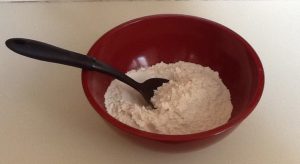There is something about cooler weather that brings out the urge to bake and fill my home with delightful aromas befitting the season. Enjoying the fruits of my labor is a tasty experience but here are 8 tips I follow during prep and afterwards to keep my baked goods safe.
- Wash my hands, baking tools, appliances, and work surfaces with soap and hot water before, during, and after food prep – clean as I go!
- Break eggs in a separate bowl before adding to the batter. This keeps shell fragments out of the batter and, if the egg is spoiled, I don’t ruin the whole project.
- Never eat unbaked flour – this includes dough and batter. Flour is considered a raw ingredient, as it is minimally processed before being packaged for use. Wheat stalks in the field come in contact with birds, rodents, and other bacteria sources, which can spread E. Coli. Raw eggs can contain salmonella so bake foods to the proper internal temperature and resist the urge to lick the bowl, spoons, and beaters.
- Use a food thermometer to check internal temperatures – a brown crust does not equal doneness. Insert the probe food thermometer in the product center and wait for the temperature to maintain a level reading. This Baked Goods Internal Temperatures Chart is a handy guide for determining internal doneness. If the outside is browned but it’s not done in the middle, lay foil lightly over the crust to prevent overbrowning and continue baking until the proper internal temperature is reached.
- Always refrigerate perishable ingredients, pies, cheese-filled breads or baked goods with perishable filling ingredients (this includes eggs, custards, cheese, pizza, meats, casseroles, cream pies, puddings, and crème puffs) within 2 hours of use, preparation, or serving at room temperature. Cookie, scone, biscuit, pie, and yeasted dough may be refrigerated or frozen for later use.
- Cool baked products on clean wire cooling racks on a clean counter or table away from where raw batter or dough are prepared. Don’t cool in the baking pans or directly on counter tops.
- Wash my hands before packaging cooled products.
- Store plain yeast breads at room temperature no longer than 1 to 2 days; freeze for longer term storage. Do not refrigerate unless the bread is filled with perishable ingredients.
Enjoy your favorite baked treats safely this holiday season and beyond!
Sources: Home Baking Food Safety 101
North American Millers Association
Latest posts by Judy Corbus (see all)
- Check Your Coverage While the Sun is Shining - July 3, 2025
- Clean Up with Homemade Cleaners - April 28, 2025
- 5 Ways to Cool Your Power Bill - August 28, 2024

